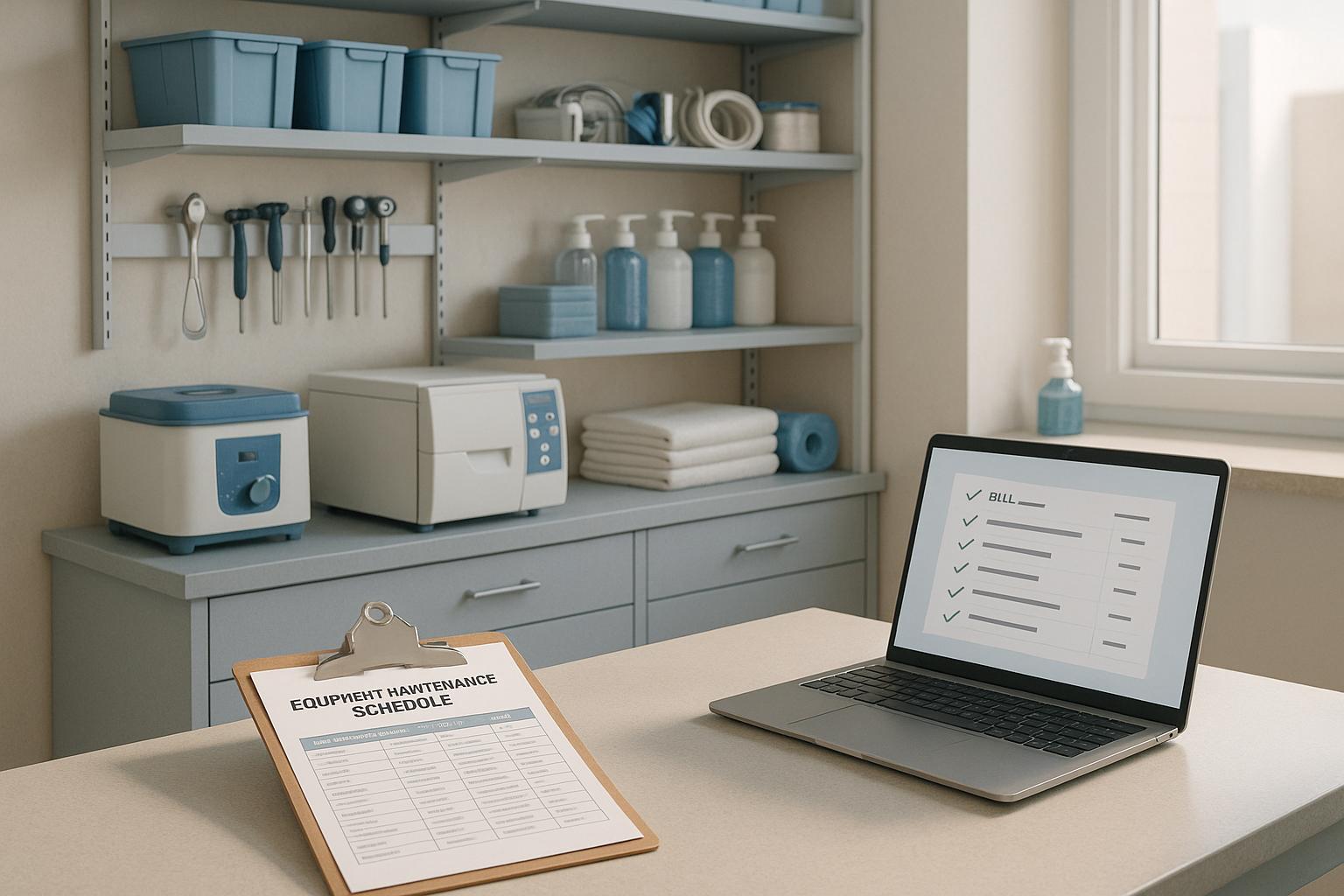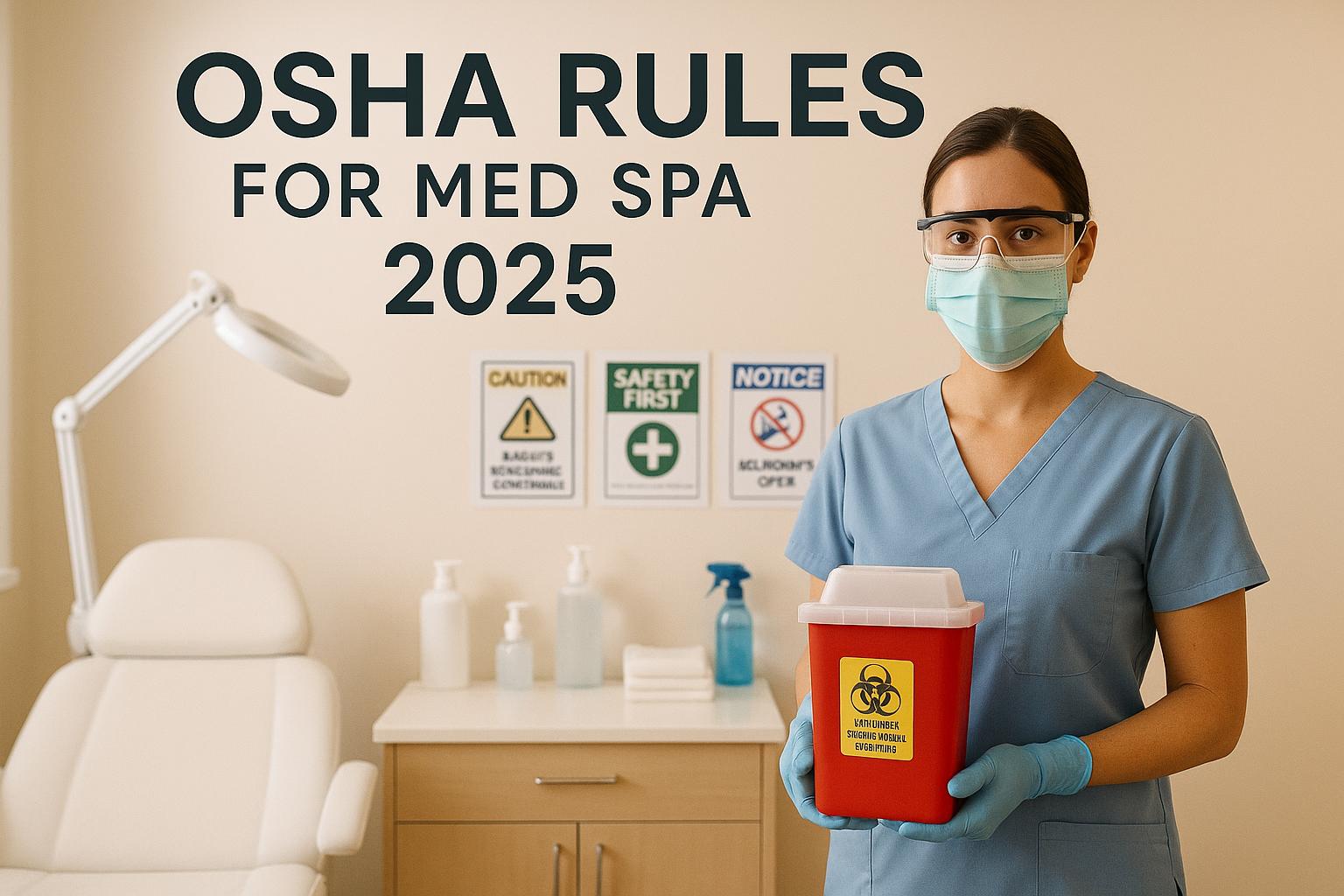Want to keep your clinic running smoothly? Start with a solid maintenance schedule.
Unplanned equipment failures can cost thousands in repairs and lost revenue, while proper preventive care can extend device lifespan by up to 78%. To avoid downtime, ensure patient safety, and comply with regulations, follow these steps:
- List all equipment: Organize by treatment type (e.g., lasers, microneedling tools).
- Follow manufacturer guidelines: Stick to recommended cleaning, maintenance, and parts.
- Meet regulations: Regular inspections and documentation are mandatory for safety and compliance.
- Create a schedule: Break tasks into daily, weekly, monthly, and annual intervals.
- Keep records: Log all maintenance activities for audits, warranties, and troubleshooting.
- Use digital tools: Platforms like Prospyr can automate reminders and streamline tracking.
Step 1: Determine Equipment Maintenance Requirements
Creating an effective maintenance schedule starts with understanding the specific care needs of your equipment. This step is crucial to ensure nothing is overlooked.
Create a Complete Equipment List
Start by compiling a detailed inventory of all the equipment that keeps your clinic running smoothly. This list should include every device and supply essential for your operations. Organize your inventory by treatment categories, such as facial treatments, hair removal, advanced skincare, and sanitation needs. For instance:
- Facial treatment equipment: Microdermabrasion machines, LED light therapy panels, ultrasonic cleaners.
- Hair removal tools: IPL devices, diode lasers, cooling systems.
- Advanced skincare devices: Radiofrequency tools, microneedling pens, chemical peel equipment.
Don’t forget to include infrastructure that impacts patient experience and operational efficiency.
When creating this list, think about your current services and any future treatments you plan to offer. Prioritizing equipment based on your clinic’s focus and client preferences will help you allocate attention where it’s needed most. Remember, the quality of your equipment directly affects the range of treatments you can provide and your clients’ comfort.
Check Manufacturer Instructions
Every piece of equipment comes with specific care guidelines from the manufacturer. These instructions are based on thorough testing and are essential for proper maintenance. Follow the recommended cleaning and maintenance schedules to keep your devices in top condition. For example, some laser systems may require daily cleaning with alcohol wipes, while others need weekly applications of specialized solutions.
It’s equally important to stick to manufacturer-approved parts for repairs and replacements. Using non-approved parts can void warranties and pose safety risks. Additionally, ensuring operators are trained to use equipment correctly can reduce maintenance issues and extend the lifespan of your devices. Digital tools, like asset tracking systems, can simplify this process by storing maintenance records, manufacturer specs, and sending automatic service reminders.
Follow Regulatory Requirements
Compliance with regulations is non-negotiable - not just to avoid penalties, but also to prioritize patient safety and uphold industry standards. Non-compliance can lead to significant consequences, such as fines, legal challenges, or even business closure. For example, HIPAA violations can result in fines up to $1.5 million annually, while FTC truth-in-advertising breaches can cost $43,792 per violation.
Medical devices regulated by the FDA require regular inspections, calibrations, and meticulous documentation. State laws also play a role, so staying informed about local requirements is crucial. Proper equipment sanitation is vital, with the CDC reporting that 1 in 31 hospital patients contracts a healthcare-associated infection. Ignoring safety, data privacy, or staff licensing can harm your clinic’s reputation. In 2022, 63% of medical spas were owned by individuals without medical degrees, highlighting challenges in securing or renewing facility licenses.
"Failure to comply with these requirements can have severe consequences, including heavy fines, legal troubles, and even the risk of shutting down your business. Moreover, overlooking crucial aspects like patient safety, data privacy, and proper staff licensing can damage your reputation and undermine customer trust." – Yocale
Regular safety audits and updates to your safety programs are essential to keep your maintenance schedule aligned with changing regulations.
"As an operation owner, it is your responsibility to be aware of the laws and regulations in your state and ensure compliance. If you fail to do so, you may face severe legal repercussions." – AP Marketing, AestheticsPro
Once you’ve mapped out your maintenance needs and compliance requirements, you’re ready to move on to building your schedule.
Step 2: Build Your Maintenance Schedule
Now that you've outlined your equipment needs and compliance requirements, it's time to turn those into a practical, structured maintenance schedule. A clear schedule ensures nothing gets missed and keeps everything running smoothly.
Group Tasks by How Often They're Needed
To stay organized, group your maintenance tasks by how frequently they need to be done: daily, weekly, monthly, quarterly, and annually. This way, every task gets the attention it requires without falling through the cracks.
- Daily tasks: Basic cleaning and safety checks.
- Weekly tasks: More thorough cleaning and basic inspections.
- Monthly tasks: Deeper cleaning, replacing filters, and performance checks.
- Quarterly or annual tasks: Professional calibrations, safety inspections, and any major updates.
Always follow the manufacturer's guidelines for task intervals to ensure you're maintaining your equipment properly.
Assign Tasks to Staff Members
Once tasks are grouped, assign them to your team based on their skills and training. Make sure everyone knows what they’re responsible for, why it matters, and how to spot potential issues. For critical tasks, set up backup responsibilities to ensure nothing is missed if someone is unavailable.
Some jobs, like annual calibrations or major repairs, may need outside technicians. Designate a team member to coordinate these external services, from scheduling to handling follow-up documentation.
Create a Schedule Table
A schedule table is a great way to keep everything organized. It should list your equipment, tasks, how often they need to be done, who’s responsible, and any completion details. Here’s an example:
| Equipment Type | Daily Tasks | Weekly Tasks | Monthly Tasks | Quarterly Tasks | Annual Tasks |
|---|---|---|---|---|---|
| Laser and Light-Based Devices | Surface cleaning, safety checks | Filter inspections | Deep cleaning | Calibration checks | Comprehensive safety audit, major updates |
| Electrosurgical Units | Cleaning, visual inspection | Output power checks, cable inspection | Safety system testing | Professional servicing | Full safety audit |
| Microdermabrasion Devices | Cleaning, sterilization | Suction power checks, filter replacement | Part replacement, deep cleaning | Professional maintenance | Safety inspection |
Digital tools like Prospyr can simplify this process. Prospyr’s task management features send reminders, track completion, and keep detailed records of all maintenance activities.
Plan maintenance during off-peak hours - early mornings or evenings work well - to avoid disrupting operations. To make record-keeping easier, add columns to your schedule table for completion dates, staff signatures, and notes on any issues found during maintenance. Keeping these records handy can help with warranty claims, audits, and troubleshooting.
sbb-itb-02f5876
Step 3: Set Up Record-Keeping and Automation
Good documentation and smart automation are the backbone of an effective maintenance program. Without proper records, you risk running into issues with compliance, warranty claims, and troubleshooting. Digital tools can make record-keeping much easier and more efficient.
Keep Detailed Records
Once you've scheduled maintenance tasks, the next step is keeping thorough records of every action taken. These records are essential for both legal protection and operational efficiency. For each piece of equipment, maintain a log that includes cleaning protocols, calibration schedules, repairs, and any incidents or malfunctions. Be sure to document the date, findings, and the staff member responsible for each task.
It's also important to track the complete history of each piece of equipment - purchase and installation dates, major upgrades, repairs, and any significant incidents. This information is crucial when deciding whether to replace a device or file a warranty claim. If you rely on external service providers, make sure to collect and store all service reports and repair documentation. A well-maintained service history is key for meeting regulatory requirements, managing insurance claims, and ensuring warranty coverage.
To keep things organized, create equipment-specific protocols based on manufacturer guidelines. Different devices often require unique cleaning agents and procedures, so detailed instructions are a must. Similarly, establish regular calibration schedules that align with both manufacturer recommendations and industry standards.
Use Digital Platforms
Ditch the paper trail and switch to digital systems for tracking and automation. Tools like Prospyr offer features that automatically send maintenance reminders, track task completion, and store records securely in a HIPAA-compliant system. These platforms handle scheduling, staff notifications, and record-keeping all in one place.
Using digital tools can reduce administrative work by over 40%, giving your team more time to focus on patient care. Centralized digital storage ensures that all maintenance records are easily accessible to authorized staff, simplifying audit preparation. Plus, real-time tracking lets you quickly spot overdue tasks, monitor completion rates, and identify patterns that might indicate a need for additional training or closer equipment monitoring.
This level of automation builds on the efficiency established during your scheduling process, keeping everything running smoothly.
Match Your Clinic's Needs
When choosing a digital platform, make sure it aligns with U.S. healthcare standards. The system should use the MM/DD/YYYY date format, display costs in USD, and comply with HIPAA regulations to protect patient data. Integration is also important - your platform should connect seamlessly with existing systems like EMR, billing, and inventory management to avoid data silos and extra work.
As your clinic grows, ensure the platform can scale to handle more equipment, staff, and locations without requiring a complete overhaul. User-friendliness is another critical factor; a complicated system can discourage staff from using it effectively. Look for providers that offer strong customer support, including video tutorials, detailed guides, and responsive help, to keep everything running smoothly.
Finally, verify that the platform offers robust reporting tools. These should allow you to quickly generate compliance documents for inspections, insurance reviews, and internal audits, completing your proactive maintenance strategy.
Step 4: Stay Compliant and Improve Over Time
Creating a maintenance schedule is just the first step. The real challenge is keeping it relevant as regulations change and finding ways to make it more effective. A maintenance program that doesn’t evolve can quickly become outdated, leaving your clinic vulnerable to compliance risks.
Review Performance Regularly
Set up monthly reviews to evaluate how well your maintenance program is working. Look at completion rates, identify recurring problems, and assess whether your schedule is effectively preventing equipment issues. Regular preventive maintenance not only extends equipment life but also enhances safety, improves quality, and reduces downtime.
Use data to guide your decisions. Keep an eye on metrics like equipment downtime, repair costs, and compliance audit results. If certain devices consistently need unscheduled repairs despite following the schedule, it might mean they require more frequent maintenance - or even replacement. Document these trends to support budget requests or adjustments to your schedule.
Consider implementing a tracking system to monitor task completion rates. Aim for an 80% completion rate for scheduled maintenance, allowing flexibility for unexpected issues or backlogged work. If completion rates fall below this benchmark, investigate whether the schedule is too demanding or if staff need additional training.
These insights don’t just help you fine-tune your program - they also ensure compliance and support ongoing improvements led by your team.
Keep Up with Regulation Changes
Staying on top of changing regulations is just as important as reviewing performance. Medical spas must adhere to both state and federal requirements, which are updated frequently. Collaborate with organizations like the American Med Spa Association (AMSPA) and the American National Standards Institute (ANSI) to stay informed.
Schedule quarterly reviews to compare your maintenance protocols with the latest regulations. Partnering with a healthcare law attorney who specializes in medical spa compliance can also be a smart move. They can help you navigate complex legal updates and ensure your schedule meets all requirements.
"Staying up to date with state regulations and equipment certifications can be overwhelming, but it's important for running a compliant and successful medical spa".
Get Staff Input
Your team’s feedback is invaluable for keeping the maintenance schedule practical and effective. Staff members often notice recurring issues or inefficiencies that might not show up in reports.
Hold regular team meetings and create quick ways for employees to report urgent concerns. If staff frequently flag problems with specific equipment, it could mean the maintenance frequency needs adjusting or that additional training is necessary.
"Create avenues for employees to provide feedback on the preventive maintenance processes through regular meetings, surveys, or dedicated suggestion boxes".
Act on staff feedback quickly, updating the maintenance program to address their concerns. Keep a record of these discussions and the changes made to show your commitment to continuous improvement.
Digital tools like Prospyr can streamline this process. These platforms allow staff to log maintenance observations directly, creating a permanent record of their input. You can also use task management features to assign follow-up actions and track their completion, ensuring that staff suggestions lead to real improvements.
In the fast-paced world of medical spas, where technology evolves and client expectations shift, regular staff input not only strengthens your maintenance program but also keeps your team engaged and informed about best practices.
Conclusion: Key Points for Equipment Maintenance Scheduling
Building a solid maintenance schedule means finding the right balance between compliance, efficiency, and cost control. By following four key steps - identifying maintenance needs, creating a schedule, establishing record-keeping systems, and focusing on continuous improvement - you can develop a maintenance program that safeguards your equipment and prioritizes patient safety.
Planning ahead is crucial. Reactive maintenance often drains 5–20% of productive capacity, while predictive approaches can increase productivity by 25%, reduce breakdowns by 70%, and cut costs by 25%.
Digital tools like Prospyr simplify the process by automating reminders, tracking task statuses, and securely managing compliance records through integrated scheduling and communication systems.
However, automation alone isn't enough. Your maintenance schedule should be treated as a dynamic plan that adapts to your practice's needs. In 2024, nearly 80% of maintenance managers reported using preventive maintenance to minimize unplanned downtime. Additionally, continuous health monitoring and targeted interventions can extend equipment lifespan by 20–40%. Regularly reviewing your schedule, gathering staff feedback, and keeping up with regulatory updates will ensure your program stays effective and compliant.
Investing in a well-designed maintenance schedule delivers measurable benefits - less downtime, longer equipment life, and enhanced patient safety. With proper planning and the right tools, maintenance evolves from a reactive task into a strategic advantage.
FAQs
What are the advantages of using digital tools like Prospyr to manage equipment maintenance schedules?
Using digital tools like Prospyr to handle equipment maintenance schedules offers a range of practical advantages. For starters, it helps keep your equipment in top shape by ensuring maintenance happens on time, which can significantly reduce the risk of expensive breakdowns. Plus, with predictive maintenance powered by real-time data, you can catch potential issues early, cutting down on unexpected downtime.
These tools also make operations more efficient by automating repetitive tasks like scheduling, tracking work orders, and performing safety checks. This not only saves valuable time but also ensures your clinic stays aligned with industry standards. By keeping your maintenance process organized with Prospyr, you can focus more energy on providing top-notch care to your clients.
How can I keep my clinic's equipment maintenance schedule compliant with regulations?
To keep up with changing regulations in the United States, it's crucial to routinely check federal and state guidelines. Agencies like CMS and the FDA provide detailed safety and quality standards for medical equipment, and staying updated on their latest requirements helps ensure your clinic remains compliant.
A proactive approach to compliance can make all the difference. Start by keeping thorough records of maintenance activities, training your team on regulatory updates, and scheduling regular audits. This not only helps you stay on the right side of the law but also improves patient safety and can even help your equipment last longer.
What can I do if my equipment keeps breaking down even with regular maintenance?
If your equipment keeps breaking down even though you’re sticking to a maintenance schedule, it might be time to take a closer look at your current practices. Make sure you’re conducting regular inspections, performing thorough cleaning, and fixing small issues before they turn into bigger problems.
You might also want to think about increasing the frequency of professional servicing - every 3 to 6 months is a good range, depending on how often the equipment is in use. These expert check-ups can uncover hidden issues, help avoid unexpected failures, and keep your devices running longer.



